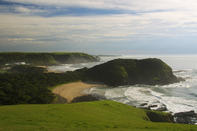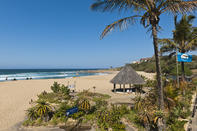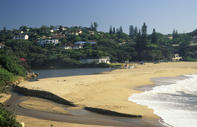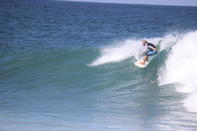A Shoreline Rich in Shipwreck Tales
Deeper into undulating Pondoland. No road follows the coast, so you will have to go inland on a long detour. The treacherous shore between Mbotyi and Mzamba remains largely inaccessible.

Many of its beaches and cliff paths, once walked by shipwreck survivors, can still only be reached on foot. The shoreline here is rich in shipwreck tales. Thousands of castaways – Portuguese, English, Dutch, Indian – have left their mark and their blood among the Xhosa clans. Those incongruous encounters have become the stuff of Wild Coast legend.
The survivors of a São João, a Grosvenor or a São Bento found themselves washed ashore on a Transkei beach (now called the Eastern Cape) and forced to confront the African Other. Initially, the castaways tried to establish old hierarchies and set up a camp constructed from flotsam on the beach. There were tents of gold cloth and silk, Persian carpets, chests of personal belongings. The slaves still obeyed orders.
Then came the decision to march, either northeast to the Portuguese settlements in Mozambique, or southwest to the Dutch Cape. The weak and the stragglers soon fell behind, the nobles could no longer coerce slaves into carrying them in litters, the wealthy discarded their possessions, starvation set in. Warriors from the hills threatened, stole, occasionally murdered. Some castaways abandoned the march to throw themselves on the mercy of a friendly chief and settled into village life.
European women would be married off, sailors took local wives. Others gave up and waited to die on the beach. Human and animal scavengers followed the dwindling band of survivors, making short work of the fallen. Only a small proportion of the original crew of most wrecks made it back to Europe. In one way or another, the coast claimed the rest.
Journeying Along the South Coast

Back on tar. The R61 descends from hinterland heights towards KwaZulu-Natal’s South Coast. Sugar plantations stretch away to the north. You will pass the Wild Coast Casino and over the Mtamvuna River on the Mitchell Bridge.
Rural Eastern Cape gives way to First World golf estates, shopping malls and blue-flag beaches. Pedalos, pancake houses, pool halls and Putt-Putt. It may seem as though you have arrived in tropical England: Ramsgate, Portobello Beach, Trafalgar, Margate. The lagoons are overhung with ilala palms and wild bananas, canoes and rowboats are for hire, the toilets are spotless and the beach sand is squeaky clean.
Although the vegetation is sumptuous, the architecture is patchy. Port Edward has a fenced caravan park and railway-worker-style houses on its prime headland. Then comes the pseudo-Spanish sprawl of San Lameer Hotel with villas and putting greens wrapped in a double row of razor-wire electrified fencing. Unable to find a local style, South Coast architects have opted for the handy formulas of Tuscany, Spain and Provence.
In Margate, the sea is an inviting blue, just a pity about the tasteless high rise buildings, the serpentine waterslide straddling what was once an idyllic lagoon, and the restaurant and municipal swimming-pool complex right on the beach. Cheek-by-jowl restaurants offer all-you-can-eat combos. There are nightclubs, discos and sports bars geared for Gauteng teenagers who descend like locusts during the holidays.
St Michaels on Sea
At St Michaels on Sea, adolescents neck in the parking lot while surf anglers cast from the rocks. Girls lay on bright towels with bikini straps undone, backs and legs glistening with sunscreen, hair falling untidily across their faces. The water is warm, the sun low. A fast, hollow right breaks along the tidal-pool wall. There are lifesavers on hand, young surfer lasses splashing each other in the shallows. No-one wears a wetsuit. After the icy south and rippy Wild Coast, this is irresistible. Surfers will be tempted to wax their boards and go in for a playful session.
You can drive across a bridge over the Mzimkulu River at Port Shepstone, once the southern border of the Colony of Natal. Today, the river is silted up, but, in the nineteenth century, it was a port for shallow-draught coasters and trading vessels able to reach fourteen kilometres upstream. Back then, the Mzimkulu was wide and deep, home to hippos and frequented by enormous shoals of king fish, salmon and turtles. Elephants drank from the stream and San lived in the caves above its banks. That all changed quickly when the Europeans waded ashore.
By Justin Fox

